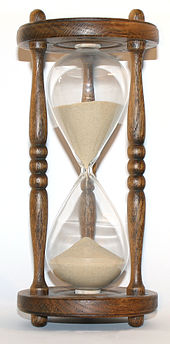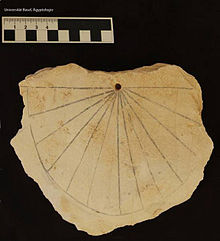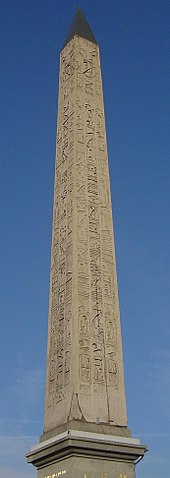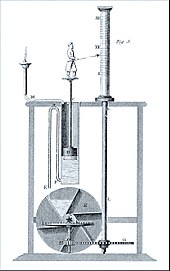
Назар аударыңыз. Бұл материалды сайт қолданушысы жариялаған. Егер материал сіздің авторлық құқығыңызды бұзса, осында жазыңыз. Біз ең жылдам уақытта материалды сайттан өшіреміз
Жақын арада сайт әкімшілігі сізбен хабарласады
қысқа мерзімді сабақ жоспарларын

The history of time and keeping devices

Дипломдар мен сертификаттарды алып үлгеріңіз!


Материалдың толық нұсқасын
жүктеп алып көруге болады
The history of time keeping devices
For thousands of years, devices have been used to measure and keep track of time. The current sexagesimal system of time measurement dates to approximately 2000 BC from the Sumerians.
The Egyptians divided the day into two 12-hour periods, and used large obelisks to track the movement of the sun. They also developed water clocks, which were probably first used in the Precinct of Amun-Re, and later outside Egypt as well; they were employed frequently by Persians and the Ancient Greeks, who called them clepsydrae. The Zhou dynasty is believed to have used the outflow water clock around the same time, devices which were introduced from Mesopotamia as early as 2000 BC.
Other ancient timekeeping devices include the candle clock, used in ancient China, ancient Japan, England and Mesopotamia; the timestick, widely used in Persia, India and Tibet, as well as some parts of Europe; and the hourglass, which functioned similarly to a water clock. The sundial, another early clock, relies on shadows to provide a good estimate of the hour on a sunny day. It is not so useful in cloudy weather or at night and requires recalibration as the seasons change (if the gnomon was not aligned with the Earth's axis).
The earliest known clock with a water-powered escapement mechanism, which transferred rotational energy into intermittent motions,[1] dates back to 3rd century BC in ancient Greece;[2] Chinese engineers later invented clocks incorporating mercury-powered escapement mechanisms in the 10th century,[3] followed by Arabic engineers inventing water clocks driven by gears and weights in the 11th century.[4]
The first mechanical clocks, employing the verge escapement mechanism with a foliot or balance wheel timekeeper, were invented in Europe at around the start of the 14th century, and became the standard timekeeping device until the pendulum clock was invented in 1656. The invention of the mainspring in the early 15th century allowed portable clocks to be built, evolving into the first pocketwatches by the 17th century, but these were not very accurate until the balance spring was added to the balance wheel in the mid 17th century.
The pendulum clock remained the most accurate timekeeper until the 1930s, when quartz oscillators were invented, followed by atomic clocks after World War II. Although initially limited to laboratories, the development of microelectronics in the 1960s made quartz clocks both compact and cheap to produce, and by the 1980s they became the world's dominant timekeeping technology in both clocks and wristwatches.
Atomic clocks are far more accurate than any previous timekeeping device, and are used to calibrate other clocks and to calculate the International Atomic Time; a standardized civil system, Coordinated Universal Time, is based on atomic time.
![]()
Timekeeping devices of early civilizations[edit]
See also: Water clock (clepsydra) and Water clock
The sun rising over Stonehenge in southern England on the June solstice
Many ancient civilizations observed astronomical bodies, often the Sun and Moon, to determine times, dates, and seasons.[5][6] The first calendars may have been created during the last glacial period, by hunter-gatherers who employed tools such as sticks and bones to track the phases of the moon or the seasons.[6] Stone circles, such as England's Stonehenge, were built in various parts of the world, especially in Prehistoric Europe, and are thought to have been used to time and predict seasonal and annual events such as equinoxes or solstices.[6][7] As those megalithic civilizations left no recorded history, little is known of their calendars or timekeeping methods.[8] Methods of sexagesimal timekeeping, now common in both Western and Eastern societies, are first attested nearly 4,000 years ago in Mesopotamia and Egypt.[5][9] Mesoamericans similarly modified their usual vigesimal counting system when dealing with calendars to produce a 360-day year.[10]
Ancient Egypt
See also: History of timekeeping devices in Egypt
Ancient Egyptian sundial (c. 1500 BC) from the Valley of the Kings. Daytime divided into 12 parts.
The oldest known sundial is from Egypt; it dates back to around 1500 BC (19th Dynasty), and was discovered in the Valley of the Kings in 2013.[11] Sundials have their origin in shadow clocks, which were the first devices used for measuring the parts of a day.[12] Ancient Egyptian obelisks, constructed about 3500 BC, are also among the earliest shadow clocks.[6][13][14]
The Luxor Obelisk in Place de la Concorde, Paris, France
Egyptian shadow clocks divided daytime into 12 parts with each part further divided into more precise parts.[11] One type of shadow clock consisted of a long stem with five variable marks and an elevated crossbar which cast a shadow over those marks. It was positioned eastward in the morning so that the rising sun cast a shadow over the marks, and was turned west at noon to catch the afternoon shadows. Obelisks functioned in much the same manner: the shadow cast on the markers around it allowed the Egyptians to calculate the time. The obelisk also indicated whether it was morning or afternoon, as well as the summer and winter solstices.[6][15] A third shadow clock, developed c. 1500 BC, was similar in shape to a bent T-square. It measured the passage of time by the shadow cast by its crossbar on a non-linear rule. The T was oriented eastward in the mornings, and turned around at noon, so that it could cast its shadow in the opposite direction.[16]
Although accurate, shadow clocks relied on the sun, and so were useless at night and in cloudy weather.[15][17] The Egyptians therefore developed a number of alternative timekeeping instruments, including water clocks, and a system for tracking star movements. The oldest description of a water clock is from the tomb inscription of the 16th-century BC Egyptian court official Amenemhet, identifying him as its inventor.[18] There were several types of water clocks, some more elaborate than others. One type consisted of a bowl with small holes in its bottom, which was floated on water and allowed to fill at a near-constant rate; markings on the side of the bowl indicated elapsed time, as the surface of the water reached them. The oldest-known waterclock was found in the tomb of pharaoh Amenhotep I (1525–1504 BC), suggesting that they were first used in ancient Egypt.[15][19][20] Another Egyptian method of determining the time during the night was using plumb-lines called merkhets. In use since at least 600 BC, two of these instruments were aligned with Polaris, the north pole star, to create a north–south meridian. The time was accurately measured by observing certain stars as they crossed the line created with the merkhets.[15][21]
Ancient Greece and Rome
See also: Clock tower, Ancient Greek technology, and Roman timekeeping
Ctesibius's clepsydra from the 3rd century BC. Clepsydra, literally water thief, is the Greek word for water clock.
Water clocks, or clepsydrae, were commonly used in ancient Greece following their introduction by Plato, who also invented a water-based alarm clock.[23][24] One account of Plato's alarm clock describes it as depending on the nightly overflow of a vessel containing lead balls, which floated in a columnar vat. The vat held a steadily increasing amount of water, supplied by a cistern. By morning, the vessel would have floated high enough to tip over, causing the lead balls to cascade onto a copper platter. The resultant clangor would then awaken Plato's students at the Academy.[25] Another possibility is that it comprised two jars, connected by a siphon. Water emptied until it reached the siphon, which transported the water to the other jar. There, the rising water would force air through a whistle, sounding an alarm.[24] The Greeks and

Сіз үшін 400 000 ұстаздардың еңбегі мен тәжірибесін біріктіріп, ең үлкен материалдар базасын жасадық. Төменде пәніңізді белгілеп, керек материалды алып сабағыңызға қолдана аласыз
 Дайын ҚМЖ. Барлық пәндерден 2022-2023 оқу жылына, жаңа бұйрыққа сай жасалған
Дайын ҚМЖ. Барлық пәндерден 2022-2023 оқу жылына, жаңа бұйрыққа сай жасалған



